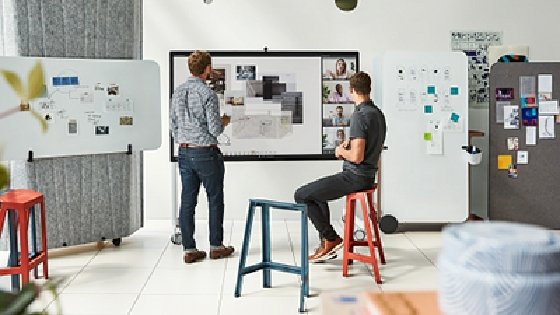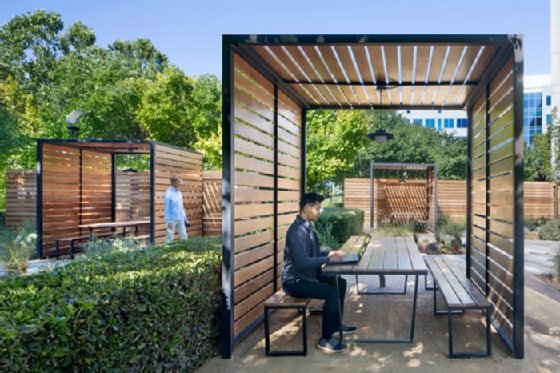
Rymden - stock.adobe.com
Should you redesign your office during COVID-19?
Contemporary office spaces must protect workers but also enable collaboration. Learn how to redesign your office so it brings workers together and keeps them safe.
As organizations implement a hybrid work model, workplaces must support both on-site and remote employees, which may require redesigning the office space.
As employee advocates, HR leaders play a starring role in this exercise. However, they should think of an office redesign as a work in progress, as advances in technology and ongoing COVID-19 uncertainty could lead to more change in the future.
Here are some factors to consider when deciding whether to redesign office space during COVID-19.
Assemble the right team
Leaders from multiple departments should help define what a redesigned workspace will look like.
Leaders in the IT, real estate facilities, design and communications departments all worked on the office redesign effort for Steelcase, said Donna Flynn, vice president of global talent at the office furniture company located in Grand Rapids, Mich. Flynn's role was to advocate for Steelcase employees, basing her input on the organization's product design research, as well as internal survey and engagement feedback.
 Donna Flynn
Donna Flynn
Including the communications department in redesign efforts was particularly crucial, Flynn said. Regular employee communication about returning to the office helped set clear expectations and avoided adding to employees' already high stress levels.
"Change has been constant for the last two years, and people are just exhausted," Flynn said. "Every little change is yet another stressor for them. Making sure that you're communicating clearly, frequently and transparently -- even if you don't know the answers -- is really important."
 Andres Pareja
Andres Pareja
Bringing in leaders who can weigh in on COVID-19 issues is also important.
Higher-ups who oversee health and safety must be part of the office redesign process, said Andres Pareja, facilities leader for the Americas region at Arup, a multidisciplinary architecture, design and engineering firm located in London.
Design for flexibility
Some companies may prioritize the image of an office as a gathering and collaboration space when considering a redesign. This is the wrong approach, said Kay Sargent, director of WorkPlace at HOK, an architecture, design, engineering and planning firm located in St. Louis.
 Kay Sargent
Kay Sargent
Physical workplace design must account for employees' focused work as well as collaboration, she said. For example, employees likely won't attend meetings for eight hours straight, even if they're in the office. They also require space to prepare for their collaboration sessions or do other focused work.
The best office designs are those known as "free choice," in which on-site employees can choose where to work, Sargent said. These designs include the following spaces:
- larger spaces for collaboration sessions;
- smaller, quieter spots for focused work; and
- gathering areas for small meetings.
"It's about creating options and choices for individuals so that they can find that perfect setting for themselves and take advantage of that," Sargent said.

Steelcase, which has redesigned its Grand Rapids headquarters and is in the process of gradually rolling out redesigns at its other locations, used this approach for its office redesign. Employees can now access "enclaves," or small rooms equipped with either a Microsoft Surface Hub for hybrid collaboration sessions or simple connection capabilities for those who need to do heads-down work on their laptops.
Large, open-concept spaces include divider screens so workers can section the rooms based on their immediate needs, such as shutting themselves off from the rest of the space if they require more privacy. Furniture and AV conferencing equipment are also mobile.
The company encourages employees to complete a survey about the new space and to send photos of the office to remote employees.
Rethink conference rooms
The hybrid work model has led to a new meetings challenge: how to ensure on-site and remote workers have an equal experience during a collaboration session.
 Gideon D'Arcangelo
Gideon D'Arcangelo
The answer to this question is still evolving, said Gideon D'Arcangelo, associate principal at Arup. One solution is on-site employees bringing their laptops to the conference room so remote participants have close-up images of everyone in the space. However, on-site employees may feel strange sitting in front of their laptops when they're in the same room. A camera in a conference room that can capture larger images could give remote employees a better view of the interactions occurring in the meeting.
However, anticipating technological change is key here.
 Leo Argiris
Leo Argiris
"[All of these are an] intermediate solution," said Leo Argiris, COO for the Americas region at Arup. As video conferencing platforms become more sophisticated, programs like Zoom may soon include features to facilitate hybrid meetings. Arup is holding off on redesigning their New York City conference rooms because company leaders believe Microsoft Teams will deliver a significantly different experience in six months to a year.
"The time is not necessarily ripe for these expenditures," Argiris said.
However, configuring conference spaces for hybrid collaboration so they meet the organization's current needs may still be the best decision for some companies.
Sargent suggested the following best practices for conference room design:
- Design rooms so that all participants -- on-site or remote -- have clear lines of sight to one another.
- Install video displays that enable on-site meeting participants to clearly see their remote co-workers.
- Incorporate adequate microphone systems so remote participants can hear their on-site colleagues.
- Consider a voice-activation camera system that focuses on the speaker in the conference room as well as panning out and capturing images of the entire on-site group.
Incorporate employee experience technology
A number of technologies enable employees to manage their work experience and could improve their workdays on site.
Sargent suggested the following technology possibilities:
- apps for hot desking and hoteling so employees can reserve space based on the type of work they're doing that day and who they'll collaborate with;
- apps that show which areas of the office are more or less densely populated so employees can find a quiet space to work or seek out conversation; and
- apps for ordering food and beverages at the cafeteria before getting to the office so employees' breakfast is ready when they arrive.
"When we start leveraging technology for those things, then we're putting power in the hands of people so that they can make better decisions about what kind of experience they want to have," Sargent said.
Prioritize health and safety
Employees must feel that they're in a safe, healthy environment when they're at the office.
Steelcase temperature check stations are located at every entrance, and employees must complete a self-check before entering the building. The company has also asked its employees to self-monitor and remain at home if they may be ill, and employees must wear masks on the premises. Steelcase also follows a strict procedure for following up on potential exposures, including quarantining.
Closed conference areas operate on reduced capacity, and workstations are physically distanced according to CDC guidelines. New filtration systems aim to boost air quality.
Technology can also play a role in measuring and communicating a building's health and safety status, D'Arcangelo said. IoT sensors can measure air quality and occupancy density, and then communicate that data to employees and visitors via digital signage or an app. Providing this information could make employees feel more comfortable on site.

"Technology can help make the workspace more attractive for people to come into and make them feel more safe and secure," D'Arcangelo said.
Outdoor spaces could also help employees feel more at ease.
Organizations will increasingly make use of their outdoor spaces such as terraces so employees can work outdoors, Sargent said. However, these spaces will need to include charging stations and shade. Fans could also make employees more comfortable outdoors on hot days.
The most effective health and safety initiative is likely requiring proof of vaccination.
Requiring employees to get vaccinated is more effective than attempting to keep a mixed population of vaccinated and unvaccinated people apart through physical distancing and plexiglass screens, Argiris said.
"Those were the things that we tried early on in the pandemic, but I think, increasingly, the idea is that it's much better to control access to the space rather than trying to keep people apart once they're inside," Argiris said.
Provide social workplace opportunities
Creating social time for employees can entice them to return to the office.
Steelcase is offering employees experiences that will hopefully make them feel comfortable on campus, reconnect with each other and reconnect with the company's purpose, Flynn said.
These include the following:
- weekly "coffee chats" in which small groups of employees are invited to connect with company executives in a relaxed, informal setting;
- outdoor social events hosted by different teams; and
- a cross-campus scavenger hunt.
Consider ongoing uncertainty
Making big redesign decisions could be risky because of ongoing COVID-19 upheaval.
Approach office redesign projects like experiments, D'Arcangelo said. They should include iteration, prototyping and continual tweaking.
"Try a lightweight idea," he said. "Be nimble about this and find the right solution that works with the nature of the organization."
Bringing back every employee at the same time may not be the right approach.
Start small by inviting one team back to the office, then see how they interact with the newly redesigned space, and what works and what doesn't, Flynn said. Or focus on one or two spaces within the building to start, then branch out from there.
"Now is the time when you have this opportunity to do something different, try some things and see what works for your employees," she said.








